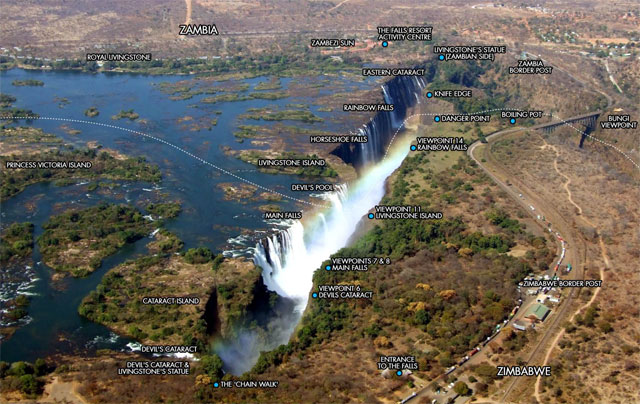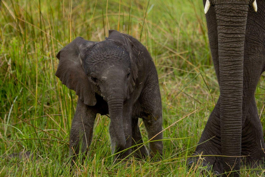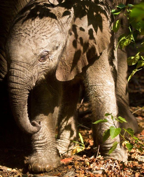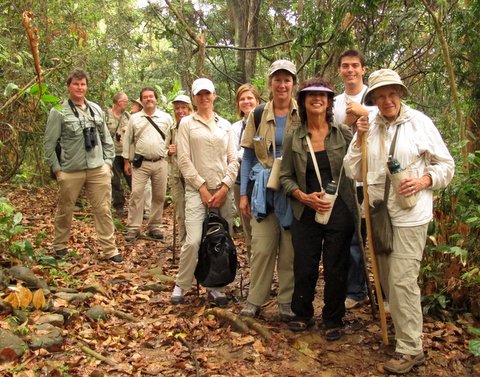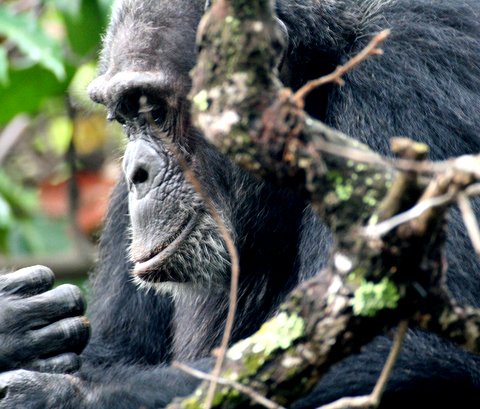One of the Seven Wonders of the Natural World and a UNESCO World Heritage site, Victoria Falls is the stuff of legends, romance and myth. An iconic draw card that features prominently on the “must see list” of travellers to south and southern Africa the sheer size, sight and sound of this magnificent spectacle never fails to inspire.
Lying on either side of the mighty Zambezi River are the towns of Victoria Falls (Zimbabwe) and Livingstone (Zambia). The tourism capitals of their respective countries Victoria Falls and Livingstone share many similarities and yet in other ways are so very different.
- The centre of Victoria Falls is essentially still a village surrounded by African bush. On the rare occasion an elephant may be spotted ambling along the main street and during the dry season it’s not unusual for them to wander through the suburbs.
- Victoria Falls depends on tourism and as a result there is a great spirit and a genuinely warm and welcoming atmosphere. The local population appreciate and understand the importance of tourism and the benefit it brings to the local community.
- The capital of the Southern Province of Zambia until 2012, Livingstone is a bustling town that nowadays depends on tourism and to a lesser extent agriculture and some manufacturing.
- The centre of Victoria Falls village is one km from the entrance to the Rainforest and the Falls whereas Livingstone town is eight kilometres away from the entrance of the Falls on the Zambian side.
- On the Zimbabwe side visitors can view 70% of the Falls and the landmark Victoria Falls Bridge from 16 spectacular viewing points along a network of trails that wind through the lush rain forest. Even during the low water months of October and November when the Falls become dry for much of their length the view from the Zimbabwe side won’t disappoint as the section known as the Main Falls and Devil’s Cataract still has water plummeting over the lip.
- The Zambian side of the Falls is known as the Eastern Cataract. From mid-October until early December the view is of a massive exposed basalt rock face.
- There is something for everyone when it comes to accommodation. Victoria Falls is home to a number of well-known and much loved hotels and a couple of lodges whereas the Livingstone side offers a wide choice of riverside lodges and a couple of hotels.
- Offering a host of diverse activities its hardly surprising Victoria Falls appeals to all age groups. Adventure seekers will relish the opportunity of white water rafting the wildest white-water in the world. Other adventure activities include canoeing, river-boarding, walking, bungi jumping, an ultimate Huey helicopter adventure flight, elephant back safaris, a canopy tour and high wire activities. More leisurely activities include a traditional helicopter flight of angels, sundowner cruises, game drives, museum, market and village visits.
- There are two 18-hole golf courses. The demanding course at Elephant Hills Hotel (Victoria Falls) was designed by Gary Player. Within earshot of the Falls the lush fairways and cropped greens are the domain of a variety of game. The Livingstone Royal Golf and Country Club with its Edwardian Club house was first established in 1908. Re-designed by Peter Matkovich this attractive course has a classic parkland environment.
- Essentially not a big game destination the Falls and the surrounding area on both sides of the Zambezi River are National Parks and are protected as a World Heritage Site. Zimbabwe boasts the Zambezi National Park as well as the Stanley & Livingstone Private Game Reserve and Zambia the Mosi-oa-Tunya National Park.
- Chobe National Park is a mere 2hrs drive from Victoria Falls and about 2hrs50 from Livingstone.
- Hwange National Park, Zimbabwe’s largest national park is a 2hrs50 – 3 hrs road transfer from Victoria Falls.
UNIQUE TO VICTORIA FALLS
- Rovos Rail offers a leisurely three day set departure itinerary between Pretoria and Victoria Falls. Guests are given a red carpet welcome upon disembarking the train at Victoria Falls Station from where they can stroll across to Victoria Falls Hotel.
- The Boma – Place of Eating is situated within the grounds of Victoria Falls Safari Lodge. Evening entertainment is in the form of a barbeque buffet with a selection of traditional Zimbabwean morsels, Ndebele dancing and music, drumming and traditional story telling.
- Excursions unique to Victoria Falls are a tree top canopy tour, a walking Wildlife Conservation and Awareness Safari in the company of professional guide Charles Brightman and game drives or walking on the Stanley & Livingstone Private Game Reserve.
- Local currency in Zimbabwe is the US dollar.
UNIQUE TO LIVINGSTONE
- The Livingstone Museum depicts the history of the town and explorer, missionary David Livingstone who first set eyes on Victoria Falls in November, 1855.
- In 1905 the Victoria Falls Railway Bridge opened and Livingstone boomed. This is when the first Jewish immigrants arrived and subsequently played a significant part in the growth of Livingstone. The Livingstone Museum, Railway Museum and Golf Club are some historic buildings that bear testament to Livingstone’s rich colonial past.
- Livingstone Island perches on the edge of Victoria Falls at a point where the water thunders down a drop of 103 meters. Access to this unique Island is only possible during low water which is usually from mid-August to mid-January. During extreme low water between October and December we highly recommend visitors to the Zambia side include a visit to Livingstone Island in their itinerary.
- Excursions unique to Livingstone are microlight flights and the Huey helicopter.
- A visit to Ebernezer Children’s Home outside Livingstone is educational and rewarding.
- Local currency in Zambia is the kwacha. All purchases made locally must be paid for in kwacha.
NB. Visitors to Zambia are required to be in possession of a valid Yellow Fever Inoculation Certificate in order to enter South Africa.
VICTORIA FALLS – WHEN TO VISIT
Stretching over a width of 1700 metres and over 100 metres in height visitors cannot fail to be inspired and amazed by the sheer size, power and beauty of this magnificent curtain of thundering water. The Zambezi River and Falls pulse with an annual flood cycle of high and low water that create completely different viewing experiences depending on the time of year. The optimal time to visit is July/August as the water flow is at medium strength thus allowing some great photographic opportunities. Rainbows arch over the Falls pretty much throughout the day, year round but it is when the spray is at its height the rainbows are at their most beautiful. At this time of year the best photographic opportunities are from the air.
January/February: is the height of the rainy season and the Zambezi River starts to rise.
March: the rains are coming to an end. River levels are high and the plume of spray is a magnificent sight that may be visible from up to 20 kilometres away.
April/May: this is when the Falls are at their maximum flow as the water from the catchment area in Zambia and Angola arrives. At high water the Falls are enveloped in a veil of mist and spray that obliterates much of the view from the ground but is a magnificent sight when viewed from the air.
June: a lovely time of year. The water level in the Zambezi gradually starts to drop.
July/August: are the best months for viewing the Falls as water spans the entire 1.7km width of the Zambezi River. As the water flow is at medium strength visitors will enjoy some great photographic opportunities.
September: towards the end of August early September the Falls are in transition from a flooded state to a low flow state. Zambia’s Eastern Cataract gradually becomes exposed.
October – November: there is little to no water flowing over the Eastern Cataract making it possible to walk across to Livingstone Island and even take a swim in Devil’s Pool. Although the Falls are at their lowest and least impressive the jagged bleakness of the exposed basalt bedrock of the Eastern Cataract and gorges has a certain stark beauty. On the Zimbabwe side there will always be some water flowing although there may be sections that are dry.
December: it’s the rainy season and despite water levels being quite low levels start to rise with rains from the local catchment areas.
For more information, contact Africa Discovery at:
1 800 886-7321, (415) 444-5100
or Email us


